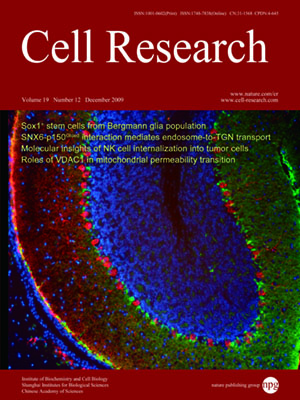
Volume 19, No 12, Dec 2009
ISSN: 1001-0602
EISSN: 1748-7838 2018
impact factor 17.848*
(Clarivate Analytics, 2019)
Volume 19 Issue 12, December 2009: 1377-1387
ORIGINAL ARTICLES
The Arabidopsis PARAQUAT RESISTANT2 gene encodes an S-nitrosoglutathione reductase that is a key regulator of cell death
Ruiqiang Chen1,2,*, Shulan Sun1,2,*, Chun Wang1,2,*, Yansha Li1,2,*, Yan Liang1,*, Fengying An1,2, Chao Li1,2, Haili Dong1,2, Xiaohui Yang1, Jian Zhang1 and Jianru Zuo1
1State Key Laboratory of Plant Genomics and National Plant Gene Research Center (Beijing), Institute of Genetics and Developmental Biology, Chinese Academy of Sciences, Beijing 100101, China
2Graduate School, Chinese Academy of Sciences, Beijing 100049, China
Correspondence: Jianru Zuo,(jrzuo@genetics.ac.cn )
Metabolism of S-nitrosoglutathione (GSNO), a major biologically active nitric oxide (NO) species, is catalyzed by the evolutionally conserved GSNO reductase (GSNOR). Previous studies showed that the Arabidopsis GSNOR1/HOT5 gene regulates salicylic acid signaling and thermotolerance by modulating the intracellular S-nitrosothiol level. Here, we report the characterization of the Arabidopsis paraquat resistant2-1 (par2-1) mutant that shows an anti-cell death phenotype. The production of superoxide in par2-1 is comparable to that of wild-type plants when treated by paraquat (1,1'-dimethyl-4,4'-bipyridinium dichloride), suggesting that PAR2 acts downstream of superoxide to regulate cell death. PAR2, identified by positional cloning, is shown to be identical to GSNOR1/HOT5. The par2-1 mutant carries a missense mutation in a highly conserved glycine, which renders the mutant protein unstable. Compared to wild type, par2-1 mutant has a higher NO level, as revealed by staining with 4,5-diaminofluorescein diacetate. Consistent with this result, wild-type plants treated with an NO donor display resistance to paraquat. Interestingly, the GSNOR1/HOT5/PAR2 protein level, other than its steady-state mRNA level, is induced by paraquat, but is reduced by NO donors. Taken together, these results suggest that GSNOR1/HOT5/PAR2 plays an important role in regulating cell death in plant cells through modulating intracellular NO level.
Cell Research (2009) 19:1377-1387. doi: 10.1038/cr.2009.117; published online 6 October 2009
FULL TEXT | PDF
Browse 2091


